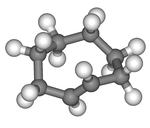Trans-Cyclooctene

| |
| Names | |
|---|---|
| IUPAC names
(E)-Cyclooctene
(Z)-Cyclooctene | |
| Other names
cis-Cyclooctene
trans-Cyclooctene | |
| Identifiers | |
3D model (JSmol)
|
|
| ChemSpider | |
PubChem CID
|
|
CompTox Dashboard (EPA)
|
|
| |
| |
| Properties | |
| C8H14 | |
| Molar mass | 110.200 g·mol−1 |
| Density | 0.846 g/mL |
| Melting point | −16 °C (3 °F; 257 K) |
| Boiling point | 145-146 °C |
Except where otherwise noted, data are given for materials in their standard state (at 25 °C [77 °F], 100 kPa).
| |
Cyclooctene is a cycloalkene with an eight-membered ring. It is notable because it is the smallest cycloalkene that can exist as either the cis- or trans-isomer with the cis-isomer more common. Its most stable cis stereoisomer can adopt various conformations, the most stable one being shaped like a ribbon;[2] its most stable trans-conformer is shaped like the 8-carbon equivalent chair conformation of cyclohexane.
 |

|
| cis-Cyclooctene | trans-Cyclooctene |
cis-Cyclooctene
cis-Cyclooctene (COE) is a substrate notoriously known for quite selectively forming the epoxide, as compared to other cycloalkenes, e.g. cyclohexene. Low amounts of radical by-products are found only. The reason for this behaviour is that allylic functionalization in cis-cyclooctene is more difficult than for other cycloalkenes, because of almost orthogonal allylic C-H bonds. Therefore, if radicals are around, they rather form epoxide (via an addition-elimination mechanism) than to form allylic byproducts.[2]
trans-Cyclooctene
trans-Cyclooctene is the smallest cycloalkene in which the trans-isomer is stable at room temperature (compared to cyclopropene for cis). This is because trans-cycloalkenes have a longer bridging distance between the two allylic carbons than their respective cis-cycloalkenes. As a result, eight carbons is the minimum ring size required to form a trans-cycloalkene without incurring severe angle strain which is the cause for the instability of smaller trans-rings. trans-Cycloheptene and trans-cyclohexene can exist, but they are very unstable at room temperature. trans-Cyclooctene exists in a helical conformation with the carbon chain lying above the double bond on one side and below it on the other, leading to chirality (as depicted to the right). This type of chirality is defined as planar chirality and the enantiomers are also considered atropisomers, as they can be thought of as resulting from restricted rotation about a single bond.[3]
trans-Cyclooctene was first synthesized on a preparatory scale by Arthur C. Cope beginning from N,N,N-trimethylcyclooctylammonium iodide and using a Hofmann elimination.[4] Other methods exist where the trans-isomer is synthesized from the cis-isomer in several synthetic steps. In addition, a photochemical method exists for this conversion in just one step:
Although the cis-trans equilibrium is unfavorable, the reaction can be driven to completion by trapping of the trans-isomer by complexation with silver.[5]
References
- ^ cis-Cyclooctene at Sigma-Aldrich
- ^ a b Ulrich Neuenschwander, Ive Hermans "The Conformations of Cyclooctene: Consequences for Epoxidation Chemistry", J. Org. Chem., Vol. 76, p.10236 (2011)
- ^ http://goldbook.iupac.org/P04681.html
- ^ Arthur C. Cope and Robert D. Bach "trans-Cyclooctene", Organic Syntheses, Coll. Vol. 5, p.315 (1973); Vol. 49, p.39 (1969)
- ^ A Photochemical Synthesis of Functionalized trans-Cyclooctenes Driven by Metal Complexation Maksim Royzen, Glenn P. A. Yap, and Joseph M. Fox J. AM. CHEM. SOC. 2008, 130, 3760-3761 doi:10.1021/ja8001919
